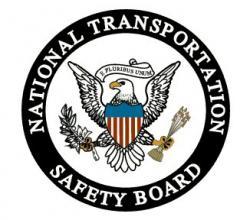Says Crew And Poor FAA Icing Certification Standards To
Blame
 The National Transportation Safety
Board determined Tuesday, January 23, the February 2005 crash of a
Cessna Citation owned by Circuit City Stores, Inc., was caused by
the flight crew's failure to effectively monitor and maintain
airspeed and comply with procedures for deice boot activation on
their approach to Pueblo, Colorado, which led to an aerodynamic
stall. Contributing to the accident was the FAA's failure to
establish adequate certification requirements for flight into icing
conditions, which led to the inadequate stall warning margin
provided by the airplane's stall warning system.
The National Transportation Safety
Board determined Tuesday, January 23, the February 2005 crash of a
Cessna Citation owned by Circuit City Stores, Inc., was caused by
the flight crew's failure to effectively monitor and maintain
airspeed and comply with procedures for deice boot activation on
their approach to Pueblo, Colorado, which led to an aerodynamic
stall. Contributing to the accident was the FAA's failure to
establish adequate certification requirements for flight into icing
conditions, which led to the inadequate stall warning margin
provided by the airplane's stall warning system.
The accident occurred on February 16, 2005, when the first of
two Cessna Citation aircraft carrying Circuit City employees to a
meeting in California crashed just east of the Pueblo Memorial
Airport. All six passengers and the two flight crewmembers were
killed in the crash.
"This accident underscores the importance of flight crews
carefully monitoring and cross checking flight instruments during
approach," stated NTSB Chairman Mark V. Rosenker. "We would also
like to see more progress from the Federal Aviation Administration
on major icing recommendations we issued a decade ago."
The Board's investigation determined that the aircraft
encountered icing conditions during the flight resulting in an
accumulation of thin, rough ice on the wing leading edges that
degraded the aircraft's performance. According to the Cessna 560
airplane (file photo of type below) flight manual (AFM),
pilots are trained to increase the landing reference airspeed
whenever any residual ice is present or can be expected during
approach and landing. An examination of the cockpit voice recorder
(CVR) did not record either pilot mention increasing the airspeed
during the approach.
Additionally, company and AFM procedures for approach and
landing in icing conditions required pilots to activate the deice
system when any ice accumulation, regardless of thickness, was
visible and to continue to monitor the wing leading edges for ice.
Despite this guidance, there is no evidence that the accident
flight crew activated the deice boots during the approach. The
flight crew of the trailing Circuit City "sister ship" did cycle
the deice boots numerous times and maintained increased airspeed
during the approach and subsequently landed safely.
As a result, the Board recommended that the Federal Aviation
Administration require that operational training for the Cessna 560
(Citation) aircraft emphasize the AFM requirements to increase
airspeed and operate the deice boots during approaches when ice is
present on the wings. The Board also recommended that the FAA
require that all airplanes equipped with pneumatic deice boots have
a mode that will automatically continue to cycle the deice boots
once the system has been activated.
 The investigation also
determined that the airplane's stall warning system did not
activate until after the aerodynamic stall occurred. The warning
system is intended to provide flight crews with adequate warning of
an impending stall allowing preventative action. Because of the
higher stall speeds occurring in icing conditions, the margin
between the warning and an actual stall can be diminished. The
Board recommended the FAA require modification of the Cessna
560's stall warning system to provide an adequate stall warning
margin in icing conditions.
The investigation also
determined that the airplane's stall warning system did not
activate until after the aerodynamic stall occurred. The warning
system is intended to provide flight crews with adequate warning of
an impending stall allowing preventative action. Because of the
higher stall speeds occurring in icing conditions, the margin
between the warning and an actual stall can be diminished. The
Board recommended the FAA require modification of the Cessna
560's stall warning system to provide an adequate stall warning
margin in icing conditions.
The Board further concluded that ice bridging does not occur on
modern airplanes; therefore, there is no reason for flight crews to
delay activation of the deice boots. The Board recommended the FAA
require guidance for aircraft with pneumatic deice boots be revised
to indicate leading edge deice boots should be activated as soon as
the aircraft enters icing conditions.
The Board also called on the FAA to develop pilot training
programs to emphasize monitoring skills and workload
management.
Additionally, the Board reiterated two recommendations issued in
1996 and 1998 to the FAA calling for revised certification
standards for aircraft operating in icing conditions. The Board has
classified the FAA's response to these recommendations as
unacceptable.
 ANN's Daily Aero-Linx (06.29.25)
ANN's Daily Aero-Linx (06.29.25) ANN's Daily Aero-Term (06.29.25): Gross Navigation Error (GNE)
ANN's Daily Aero-Term (06.29.25): Gross Navigation Error (GNE) Classic Aero-TV: Anticipating Futurespace - Blue Origin Visits Airventure 2017
Classic Aero-TV: Anticipating Futurespace - Blue Origin Visits Airventure 2017 NTSB Final Report: Cirrus SR22
NTSB Final Report: Cirrus SR22 Airborne Affordable Flyers 06.26.25: PA18 Upgrades, Delta Force, Rhinebeck
Airborne Affordable Flyers 06.26.25: PA18 Upgrades, Delta Force, Rhinebeck




